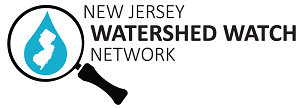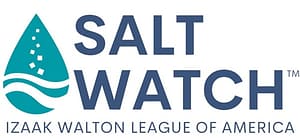Thank you for your participation during the 2023/2024 season. We have run through our supply of test strips, so we hope to see you again next year!
NJ Watershed Watch Network launched NJ Salt Watch in December 2020 to monitor the effects of winter road salting on our freshwater streams and lakes. Since then, about 550 volunteers have collected more than 2,300 chloride measurements across the state, helping to fill in gaps in our understanding of the extent of this issue. Municipalities can use this data to assess their current road salt strategy – and earn 5 points toward Sustainable Jersey Gold Star in Water.
Volunteers select their favorite New Jersey freshwater stream, river, lake, or pond and return to that spot multiple times over winter to track how chloride levels change over time – and after a couple road salt applications.
Get Started
Request your test strips: Submit an online request form to receive your free chloride test strips. The package will arrive by mail in a few weeks.
Pick a stream or lake site to monitor: You will return to this site several times this winter, so make sure your site is safe and accessible. The waterbody should be freshwater and nontidal, but can be located in any part of New Jersey. We are interested in data from multiple types of land uses (i.e. urban, rural, agricultural).
Learn about your waterbody: To be eligible for this project, your stream, river, lake, or pond should be freshwater and nontidal. Wondering if your waterbody meets this criteria? Most in New Jersey do, but if you live near the ocean or a tidal river, you should check to make sure. Click here to head to NJ GeoWeb map system, zoom in on your location, and see if the head of tide (the blue target) is downstream of your intended monitoring location. If so, you’re good to go. Make sure you have permission to return to this spot several times this winter – public land is fair game!
Keep an eye on the weather forecast: To find out if chloride levels spike after a road salting event, we are interested in data collected in both dry and wet weather. Take a “dry” measurement when there hasn’t been rain, snow, or snowmelt within 72 hours. Take a measurement on a “wet” day, when rain, snow, or snowmelt washes road salt into the water.
Visit your site 3-5 times before the end of April: Testing takes about 10 minutes tops, so some volunteers stop at multiple sites during each monitoring event. See below for test instructions.
Enter your data to the Clean Water Hub: Create an account on the Clean Water Hub to submit your chloride data to the national database. You will be prompted to affiliate yourself with an organization to submit data on their behalf. Select “New Jersey Watershed Watch Network”. You can list multiple organizations here if you are collecting data under another regional group as well.
Frequently Asked Questions
- The Clean Water Hub is a great practice in patience! It may take up to 10 seconds for your page information to load, and you may see the default map of Ellington in the meantime. You can also try to push things along by refreshing the webpage. We really appreciate you hanging in there!
Log in to your Clean Water Hub account, click ‘My Sites’ in the top menu, then scroll down to click ‘My Organizations’ in the lower menu. This will list all of your current organizational affiliations. If you don’t see New Jersey Watershed Watch Network listed, click here to join us so we can access your data and assist with corrections if needed. After joining the organization, please click on each of your sites to affiliate them with New Jersey Watershed Watch Network. Click the pencil icon to edit your site information – and add a site photo if you like!
Each test strip lot has a slightly different measurement range, but generally fall between 30-650 mg/l chloride. If your test strip reading is below the conversion chart range, enter ‘0’ mg/l. If your reading is “off the charts”, enter ‘650’ mg/l. This does not mean that your actual reading was 0 or 650 mg/l, but we use these values as placeholders.
Record the closest Quantab unit to find its corresponding chloride reading on the calibration chart. Please don’t try to estimate the average chloride concentration.
The test strip lot # and expiration date are required to enter data in the Clean Water Hub. Your lot # can be found on your packet of test strips and associated calibration chart.
2022/2023 Lots
- Lot # 2269: 9/2024
- Lot # 2312: 10/2024
- Lot # 2341: 11/2024
2023/2024 Lots
- Lot # A3220A: 7/2025
- Lot # A3270A: 9/2025
Though our previous form required them, the Clean Water Hub does NOT accept photo submissions of completed test strips. It is still a best practice to take a photo of your completed test strip, which will save the time and location, in case we have questions about your data later!
Clean Water Hub only accepts photos in .jpeg or .png file formats. iPhone photos saved as an .HEIC file type will not save.
Chloride Levels in New Jersey
In November 2023, NJ Salt Watch switched data entry platforms from Survey123 to the Clean Water Hub, which consolidates NJ data with Salt Watch partners nationwide. Click here to view current nationwide chloride data on the Clean Water Hub.
View our assessment of Salt Watch data collected between December 2020 and July 2023 to find out if your municipality or watershed is considered ‘impaired’ for chloride. Click here to view the map in a new window.
NJ Salt Watch data can be used to produce regional assessments of chloride impairment. Click here to view sites and results from the Musconetcong Watershed Association and read about their quest to develop a regionally-specific ratings curve between chloride and conductivity to expand our ability to measure the impact of road salt.
How to Reduce your Salt Footprint
Our friends at the Lake George Association and Wisconsin Salt Wise have developed a great list of resources for you – and your local municipality and state Department of Transportation – to help reduce the amount of salt we use every winter.
Learn more with recent NJ road salt webinars:
Road Salt in New Jersey Technical Friday Webinar (The Watershed Institute, Nov. 11, 2022)
Road Salt Virtual Roundtable (Musconetcong Watershed Association, Nov. 16, 2022)
Deicers and the Environment Webinar (Barnegat Bay Partnership, Feb. 22, 2023)
Sustainable Jersey: Winter Best Practices to Reduce Road Salt Impacts
In October 2023, Sustainable Jersey launched a new action for municipalities to improve winter road maintenance through workforce training, salt application tracking, equipment calibration, and implementation of other best practices. Participation in NJ Salt Watch earns municipalities 5 points toward completion of this action! Click here to learn more about Sustainable Jersey and winter best practices.
Thank you to the Izaak Walton League of America Salt Watch Program for sharing their methods!

